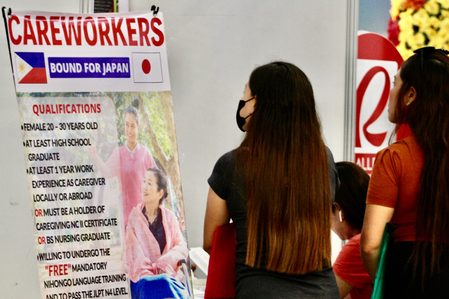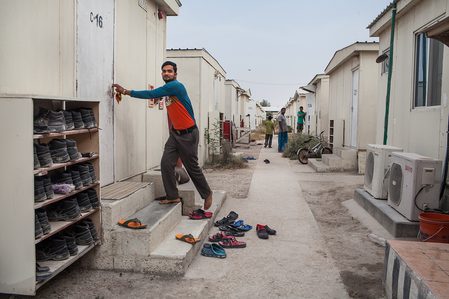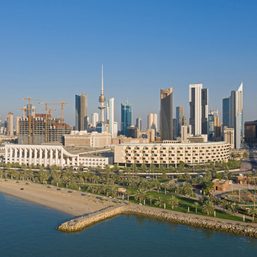SUMMARY
This is AI generated summarization, which may have errors. For context, always refer to the full article.
![[DASH of SAS] The Philippine labor export policy needs an overhaul – stat](https://www.rappler.com/tachyon/2024/01/tl-ph-labor-export.jpg)
Ever since the Philippines began its policy of outsourcing its job employment – or exporting its labor – under the first Marcos president, the Middle East has been the main destination for overseas Filipino workers.
Exporting our local talent was supposed to be a stop-gap measure, to fill in the employment gaps that the local market could not. Today, under another Marcos presidency, there are a millions Filipinos scattered across the Middle East. According to government data, Saudi Arabia is the leading destination for OFWs. Of the total 1.96 million OFWs in 2022, about 23% worked in Saudi Arabia, 13.7% in the United Arab Emirates (13.7%) and 7% in Kuwait.
The Middle East, because of its citizenship rules and notoriously exploitative working conditions for guest workers, is a country where employment is temporary and a path to residency is elusive. The government policy of deploying OFWs to the Middle East needs an overhaul and needs to consider these labor dynamics and developing trends in the labor market.
1. A ‘work and then leave’ employment policy
The very nature of employment in the Middle East is “work and then leave.” Jobs available to guest workers are short-term contract jobs of generally two years. When you think about it, it is only slightly better than the six-month contractualization policy in the Philippines. OFWs delay getting on the relentless and vicious hamster wheel of job hunting but don’t escape it.
I would argue that job hunting becomes more expensive after being on a job stint abroad. OFWs I have interviewed have spoken about how available jobs in the local market are not aligned with the skills they learned abroad, leaving them unemployable despite overseas work experience. Having earned a higher salary abroad also makes local jobs less attractive. Instead of being a stop-gap measure to fill in an employment gap, being an OFW becomes a career, with a big price tag. Expensive recruitment fees and other incidental costs like government documents are incurred for nearly every new overseas job contract, forcing OFWs to go into debt even before they start working.
But because there are limited paths to residency in the Middle East, at one point, our OFWs will have to come home to the Philippines to retire. When that time comes, what will they come home and retire to?
2. Labor market disruptions leave workers without work and without pay
The outbreak of the COVID-19 pandemic brought economies all over the world to a shrieking halt. Businesses in the Middle East packed up operations to cut down costs, leaving thousands of migrants without a job. Domestic workers employed by private employers were left outside their embassies and consulates.
An estimated 300,000 to 400,000 OFWs were affected by lay-offs and pay-cuts and the Philippines saw the largest expatriation of migrant workers in recent history. The Philippines was ill-prepared for the repatriation but it should have served as another stinging reminder of how overseas employment only offers a higher salary but not job security or redress for workers affected by pay-cuts or business closures.
Take for example, the 10,000 construction workers Migrante International estimates to have been laid off in Saudi Arabia when construction firms in the Arab nation declared bankruptcy – way back in 2015 and 2016.
Current president Marcos, Jr. has promised that the workers would be paid, relaying a promise that was made to him by the Saudi crown prince. However, as of October 2023, the government reported that Saudi Arabia is still processing the claims – more than 9 years after.
Even at the highest levels of diplomacy – with heads of state coming to a so-called agreement – justice for violation for worker rights remains a struggle.
3. The triple D of the Kafala system: Degrading. Dehumanizing. Deadly.
The Middle East is notorious for its abusive working conditions that human rights watch dogs have likened to the cruelty of slavery. Domestic workers employed in private homes are the the most vulnerable.
Employer-employee relations in the Middle East, governed by the kafala system, enables this very unequal employer-employee relationship. The kafala system essentially prevents an employee from leaving or changing their employer without the permission of their employer – or risk losing their work and residency permit. If you try to escape an abusive employer, as many domestic workers have reportedly tried, you risk getting being charged with absconding and imprisoned. Or you can die trying to escape. In Lebanon, one domestic worker dies every week from unnatural causes, suicide and attempted escape being the most common causes, Human Rights Watch reported in 2022.
4. The Middle East is shifting its employment policy to employ more of their own nationals
The Saudi Arabian government has implemented the Saudization plan or the Saudi Nationalization Scheme which requires companies to prioritize hiring Saudi nationals and meet certain employment quotas. Earlier this month, local Saudi press reported that the Labor Ministry announced the expansion of the Saudization to include new professions and activities such as: project management; procurement and sales; outlets providing services for shipping activities and freight brokerage; and outlets for decor and women’s tailoring.
Labor rights groups have been sounding the alarm for years now, warning the government to prepare for the time when Saudization kicks in and job opportunities for guest workers dry up.
Other global factors such as the growing worldwide demand to lessen dependency on oil (the backbone of the economy of many of the Arab nations) and lessons from COVID-19 have pushed other Gulf countries to cut back on hiring foreign talent and employ more of their citizens first.
As the Middle East, the Philippine’s largest “employer” of overseas contract workers, shifts it priorities to creating jobs for more of their nationals, the Philippine government should do the same. – Rappler.com
Ana P. Santos is an investigative journalist and writer who writes about the intersections of gender, sexuality, and labor migration. She completed a postgraduate degree in Gender (Sexuality) from the London School of Economics and Political Science as a Chevening Scholar. Follow her on Instagram at @anaallsaints.
DASH of SAS is a spin-off of her videos on sexuality entitled ‘Sex and Sensibilities’ (SAS). Watch here.
Add a comment
How does this make you feel?

















There are no comments yet. Add your comment to start the conversation.